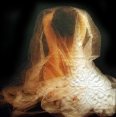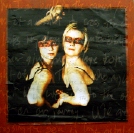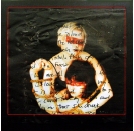In June of 2002, Bonny Lhotka and I had an opportunity to print for two days with Larry Loser at Applied Visual Concepts. His 84” flatbed printer was the first of it’s kind in the United States. It prints on virtually any substrate up to 1.58” thick with inks which are UV cured. In two days we each printed approximately 20 images, some on both the back and front of transparent media. Larry and the printer, (which prints at up to 140 square foot per hour and an apparent 720 dpi), spent most of their time waiting for us to prepare files, choose substrates and exclaim over the quality of the prints.



I was working on a series called “Body + Soul”. For the first image, we initially intended to print on a 24” square embossed tin ceiling tile which I had spray painted white. The images above show Larry straightening the tile, the tile nailed to plywood passing through the back of the printer and the print emerging from the front of the printer. Because the printer can print on glass and plexiglas as well as metal and wood, I decided to print the image a second time on 3/4” polycarbonate and place it in front of the embossed tile. The photograph below doesn’t do justice to the rich blacks, glowing colors and sense of mystery created by the pattern of the tile seen through the lighter portions of the image.


The next piece was also printed on 3/4” polycarbonate. To give the impression of being seen through a window, I turned the print over and reprinted the cross bars and outer edges on the opposite side. That side, with texture showing, became the front. Behind this two-sided print I glued a plexiglas mirror which reflects the printed image, the ambient surroundings and the viewer. It gives the appearance of being an antique mercury mirror with a distressed backing



The final group of images were printed on sheets of galvinized steel and on wrinkled sheets of tin and lead nailed to plywood which extended beyond the metal. (See detail left.) The printer creates a smooth transition across varied materials.
Because the ink sits on the surface of the substrate it has a tactile quality resembling a serigraph. This physicality, coupled with the ability to print on virtually any surface with inks that are impervious to damage are major breakthroughs in technology for fine artists. Although this printer is not affordable for individuals, having an artist-friendly printer who can print individual pieces or provide a day or two of intensive printing is a wonderful advantage in putting together a complex body of work quickly.
Dorothy Simpson Krause • 800 Lakeside Circle #605, Pompano Beach, FL 33060 • 781 424 5276 • DotKrause@DotKrause.com